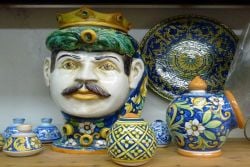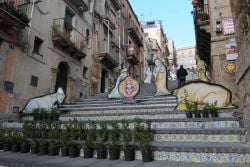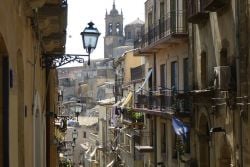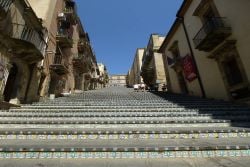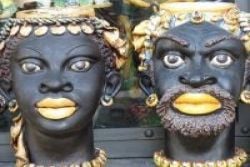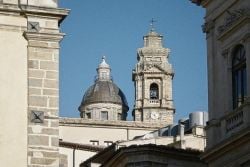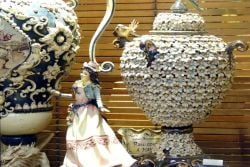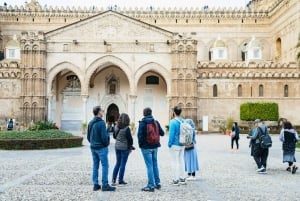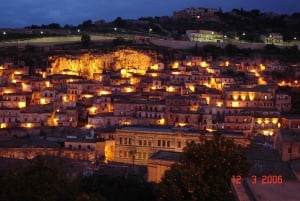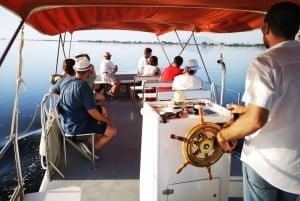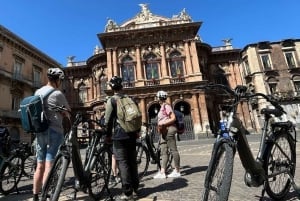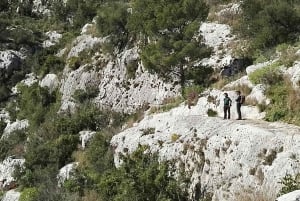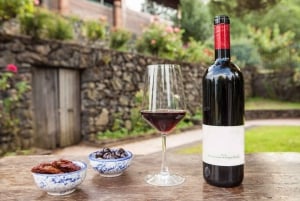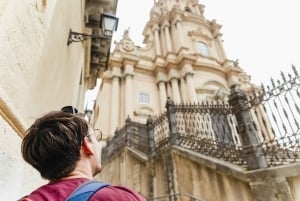Caltagirone
Caltagirone has long been famous for the production of pottery. The Orientals brought the art of polychrome gazed ceramics to the town. The name Caltagirone derives from the Arabic “Qalat al-ghiran”, meaning castle above caves, and attests to the antiquity of its pottery works. Two necropolises near the town, dating from the second millennium BC, show us that it has been inhabited since prehistoric times. In the year 1030 the Arab castle was attacked by the Byzantine general George Maniakes and his Ligurian troops. Obviously many Ligurian soldiers did not go back to where they came from, because in the local dialect you can find many words of the Ligurian language. Flourishing under the rule of Norman and Hohenstaufen kings, Caltagirone became one of the most important centres for the production of ceramics in Sicily, in particular terracotta wares and majolica. Arabs, Byzantines and Normans ruled this part of the island for some two thousand years.
The entire city was destroyed by the devastating earthquake of 1693 and has been rebuilt in Baroque style, same as Ragusa, Modica, Noto, Catania and many small towns of the “Val di Noto”, which is one of Sicily’s UNESCO World Heritage Sites.
Just wander this Baroque town, have a look at the churches and into the numerous ceramics shops, walk up the famous stairway Scala di Santa Maria del Monte, learn all about the history of Sicilian pottery at the Museo della Ceramica, relax in the beautiful town park and pay a visit to a ceramics factory. If you are travelling with children and plan to stay more than one day in the area: some factories offer pottery courses for children and adults. More ideas how to entertain your kids you'll find at here
Things to do and see in Caltagirone
Scala di Santa Maria del Monte
The city’s most famous sight is the imposing stair of Saint Mary, featuring 142 wide steps decorated with individually hand crafted majolica tiles, using styles and figures derived from the millennial tradition of pottery making. It is also one of Sicily’s most photographed sights. Best times to visit to “La Scala” are on 24th and 25th of July and 14thand 15th of August, when candles and 4000 cylinders of coloured paper holding oil lamps form a tapestry design. At 21.30 h on these nights hundreds of young people come into action to light the lamps, so that the staircase flares up all at once. Visitors and tourists are very welcome to participate.
Other interesting places worth visiting are the Cattedrale di San Giuliano, which is of Norman origin and features an art nouveau façade dating back to the beginning of the 20th century, the Chiesa di Gesù for the eight statues in its façade, portraying saints and the Madonna and Child, the 12th century Chiesa di Santa Maria del Monte, the Renaissance Chiesa dei Cappuccini, which is completely made of white stone, housing a noteworthy treasure and a picture gallery, and the former town hall, the 15th century Palazzo Senatorio.
Museo della Ceramica - Ceramics Museum
As Caltagirone was declared a UNESCO site not only for its Baroque churches but mainly for its ceramics, you should pay a visit to the Museo della Ceramica, which is located in the beautiful town park. The museum features one of Sicily’s most extensive pottery collections. On display is pottery from Neolithic finds, terracotta ware from the 5th century BC to 18th century nativity figures, floor tiles, majolica tiles – an immense collection of ancient and modern terracotta and pottery. If you didn't know about Sicily's ceramic tradition, you will after you've visited here.
Shopping in Caltagirone
We guess that you guessed: shopping in Caltagirone means shopping ceramics. The town is plastered with pottery shops, in many of them you can have a look over the shoulders of the artists while they are working. You will find everything from figures, bowls, plates, vases and ashtrays to tiles and home and garden decoration. Big shops ship, so you won’t have to carry home your precious but fragile and probably heavy souvenir. Don’t buy in the first shop, always compare the prices. More souvenirs - also less weighty ones - you wil find at our Shopping page
Accommodation in Caltagirone
Caltagirone has a selection of hotels and B&Bs, and offers in its surroundings some agriturismos and country houses. Most of the hotels are located in the new part of the town. Please see Accommodation
Restaurants in Caltagirone
The most sought after places are near or even on the stairs themselves. There are plenty of good restaurants. You would think that the restaurants and pizzerias located in or next to the main attraction – the stairs – are expensive tourist traps. You are wrong: while staying in Caltagirone, have a pizza at Pizzeria La Scala, half way up the stairs. They are delicious and you will enjoy your lunch or dinner in one of the most atmospheric places of the town. Find more restaurants here
Events in Caltagirone
The festival “La Scala Infiorata” takes place on 8th of May and 2nd of June when all steps are decorated in honour of the “Madonna di Conadomini” with plants and flowers of all colours.
Every third Sunday of the month an antiques and flea market is held in the historic centre.
More annual events in Sicily you will find here
How to get to Caltagirone
By bus & train
Caltagirone lies 64 km south west of Catania, 30 km from Piazza Armerina and 34 km north east of Gela. The town is serviced by buses and trains. Operating bus companies are Azienda Siciliana Trasporti (AST), SAIS Autolinee and Etna Trasporti. SAIS connects Caltagirone with Palermo, AST with Catania and Syracuse.
By car
From Palermo take the A 19 – exit at Enna and follow the directions for Piazza Armerina – San Michele di Ganzaria – Caltagirone. From Messina, Taormina and Catania take the A 18, then SS 417 – exit Caltagirone Sud. From Siracusa the SS 114 – exit Caltagirone Sud, from Agrigento SS 115 to Licata – Gela, then SS 417 to Catania – exit Caltagirone Sud
By airplane
Next international airport is in Catania.


